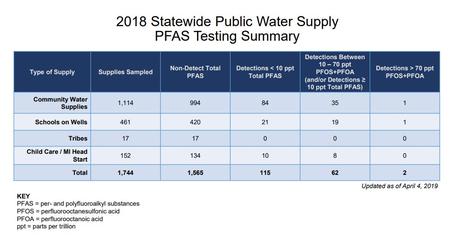Where’s the PFAS? Michigan Leads in Detection of Contaminant [MAP]
Michigan has most known sites in U.S., but is also doing the most testing.

Environmentalists, health experts and public officials are growing more concerned about a group of chemicals found in dozens of sites across Michigan.
PFAS (per- and polyfluoroalkyl substances) are a large family of human-made compounds that have been used in a wide range of consumer products, such as carpeting, waterproof materials and upholstery. They’re also found in firefighting foam. Manufacturers have been using PFAS for decades, and varying amounts of the chemicals have been detected near industrial sites and military bases. When products containing the chemicals are spilled, they can work their way through the ground, lakes and rivers into drinking water supplies. The Michigan Department of Environmental Quality tested nearly 2,000 potential contamination sites in 2018. It found only two where PFAS exceeded the U.S Environmental Protection Agency’s lifetime health advisory of 70 parts per trillion, but 189 sites had some level of PFAS.

The Environmental Working Group has created an interactive map showing where these sites are. Users can click on the map to learn more about each location. The organization says it has mapped more than 600 sites in 43 states. Michigan has the most of any state, but that’s largely because the MDEQ has been actively testing for PFAS.
Click here to see and use the map
“Michigan has actually been a leader nationwide in testing,” says Nick Schroeck, director of clinical programs at the University of Detroit Mercy School of Law and an expert in environmental law and policy. “In Michigan, we’ve been sampling and looking for it more, so on this map from the Environmental Working Group we’re seeing more sites because we’re looking more than other states.”
Schroeck and other environmentalists say the EPA’s PFAS limit of 70 parts per trillion is too high. The Centers for Disease Control and Prevention says PFAS can affect a person’s health at about 10 ppt. While more research is needed on the health risks of PFAS exposure, the MDEQ says studies have shown the chemicals may increase cholesterol levels and raise the risk of certain cancers and thyroid disease. The Environmental Working Group is calling on the EPA to set a limit of 1 ppt.
Click on the audio player above to hear the conversation with WDET’s Pat Batcheller.
More PFAS stories from WDET:
Michigan Could Be On the Verge of Another Drinking Water Crisis
State Works to Get Ahead of PFAS Problem in Michigan
